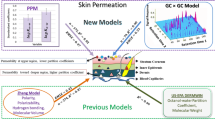Abstract
The combined effects of 1-menthol and ethanol as a skin permeation enhancer were evaluated with two equations describing the permeability coefficient through full-thickness skin (P FT) and the full-thickness skin/vehicle concentration ratio (C FT/C V) of drugs as a function of their octanol/vehicle partition coefficient (K OV). A two-layer model was applied for skin, which consists of a stratum corneum (SC) with lipid and porous pathways and a viable epidermis and dermis (ED). The two equations contain one variable (K OV) and nine coefficients, six of which (three diffusion coefficients, the porosity of the SC, and two terms of the linear free energy relationship) were considered different, dependent on the drug vehicle. In vitro permeation of four drugs (morphine hydrochloride, atenolol, nifedipine, and vinpocetine) was determined using excised hairless rat skin and four aqueous vehicles (water, 5% 1-menthol, 40% ethanol, and 5% l-menthol–40% ethanol) to measure each P FT. Drug concentrations in full-thickness skin were also measured to obtain C FT/C V. A nonlinear least-squares method was employed to determine six coefficients using the two equations and experimentally obtained P FT and C FT/C V. The addition of 1-menthol to water and 40% ethanol increased the diffusion coefficient of drugs in lipid and pore pathways of SC, whereas the addition of ethanol to water and 5% 1-menthol increased the drug solubility in the vehicle, decreased the skin polarity, and increased the contribution of the pore pathway to whole-skin permeation.
Similar content being viewed by others
REFERENCES
B. W. Barry. Mode of action of penetration enhancers in human skin. J. Control. Release 6:85–97 (1987).
A. C. Williams and B. W. Barry. Terpenes and the lipid-protein-partitioning theory of skin penetration enhancement. Pharm. Res. 8:17–24 (1991).
M. Hori, S. Satoh, H. I. Maibach, and R. H. Guy. Enhancement of propranolol hydrochloride and diazepam skin absorption in vitro: Effect of enhancer lipophilicity. J. Pharm. Sci. 80:32–35 (1991).
E. R. Cooper. Increased skin permeability for lipophilic molecules. J. Pharm. Sci. 73:1153–1156 (1984).
H. Sasaki, M. Kojima, J. Nakamura, and J. Shibasaki. Enhancing effect of combining two pyrrolidone vehicles on transdermal drug delivery. J. Pharm. Pharmacol. 42:196–199 (1990).
M. Hori, S. Satoh, and H. I. Maibach. Classification of percutaneous penetration enhancers: A conceptional diagram. J. Pharm. Pharmacol. 42:71–72 (1990).
Y. Morimoto, K. Sugibayashi, D. Kobayashi, H. Shoji, J. Yamazaki, and M. Kimura. A new enhancer-coenhancer system to increase skin permeation of morphine hydrochloride in vitro. Int. J. Pharm. 91:9–14 (1993).
T. Hatanaka, M. Inuma, K. Sugibayashi, and Y. Morimoto. Prediction of skin permeability of drugs. I. Comparison with artificial membrane. Chem. Pharm. Bull. 38:3452–3459 (1990).
A.-H. Ghanem, H. Mahmoud, W. I. Higuchi, U. D. Rohr, S. Borsadia, P. Liu, J. L. Fox, and W. R. Good. The effects of ethanol on the transport of β-estradiol and other permeants in hairless mouse skin. II. A new quantitative approach. J. Control. Release 6:75–83 (1987).
B. D. Anderson, W. I. Higuchi, and P. V. Raykar. Heterogeneity effects on permeability-partition coefficient relationships in human stratum corneum. Pharm. Res. 5:566–573 (1988).
P. V. Raykar, M.-C. Fung, and B. D. Anderson. The role of protein and lipid domains in the uptake of solutes by human stratum corneum. Pharm. Res. 5:140–150 (1988).
C. G. Pitt, Y. T. Bao, A. L. Andrady, and P. N. K. Samuel. The correlation of polymer-water and octanol-water partition coefficients: Estimation of drug solubilities in polymers. Int. J. Pharm. 45:1–11 (1988).
G. L. Flynn, S. H. Yalkowsky, and T. J. Roseman. Mass transport phenomena and models: Theoretical concepts. J. Pharm. Sci. 63:479–510 (1974).
K. Sato, K. Sugibayashi, and Y. Morimoto. Species differences in percutaneous absorption of nicorandil. J. Pharm. Sci. 80:104–107 (1991).
Y. Morimoto, K. Sugibayashi, K. Hosoya, and W. I. Higuchi. Penetration enhancing effect of Azone on the transport of 5-fluorouracil across the hairless rat skin. Int. J. Pharm. 32:31–38 (1986).
R. W. Baker and H. K. Lonsdale. Controlled release: Mechanism and rates. In A. C. Tanquary and R. E. Laceys (eds.), Controlled Release of Biologically Active Agents, Plenum Press, New York, 1974, pp. 15–72.
M. Okumura, K. Sugibayashi, K. Ogawa, and Y. Morimoto. Skin permeability of water-soluble drugs. Chem. Pharm. Bull. 37:1404–1406 (1989).
K. Tojo, C. C. Chiang, and Y. W. Chien. Influence of donor solution upon skin permeation of drug. J. Chem. Eng. Jap. 19:153–155 (1986).
J. P. Skelly, V. P. Shah, H. I. Maibach, R. H. Guy, R. C. Wester, G. Flynn, and A. Yacobi. FDA and AAPS report of the workshop on principles and practices of in vitro percutaneous penetration studies: Relevance to bioavailability and bioequivalence. Pharm. Res. 4:265–267 (1987).
T. Kokubo, K. Sugibayashi, and Y. Morimoto. Mathematical models describing the drug release kinetics from pressure sensitive adhesive matrix. J. Control. Release 20:3–12 (1992).
K. Yamaoka, Y. Tanigawara, T. Nakagawa, and T. Uno. A pharmacokinetic analysis program (MULTI) for microcomputer. J. Pharmacobio-Dyn. 4:879–885 (1981).
D. Bommannan, R. O. Potts, and R. H. Guy. Examination of the effect of ethanol on human stratum corneum in vivo using infrared spectroscopy. J. Control. Release 16:299–304 (1991).
P. Liu, T. Kurihara-Bergstrom, and W. R. Good. Cotransport of estradiol and ethanol through human skin in vitro: Understanding the permeant/enhancer flux relationship. Pharm. Res. 8:938–944 (1991).
Author information
Authors and Affiliations
Rights and permissions
About this article
Cite this article
Kobayashi, D., Matsuzawa, T., Sugibayashi, K. et al. Analysis of the Combined Effect of 1-Menthol and Ethanol as Skin Permeation Enhancers Based on a Two-Layer Skin Model. Pharm Res 11, 96–103 (1994). https://doi.org/10.1023/A:1018953929457
Issue Date:
DOI: https://doi.org/10.1023/A:1018953929457




